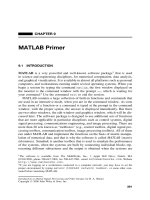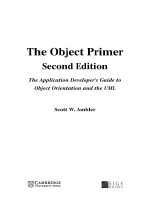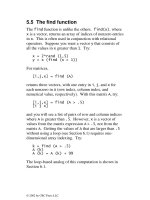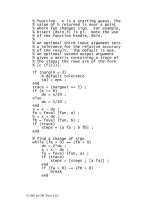MatLab Primer 7th Edition - Preface
Bạn đang xem bản rút gọn của tài liệu. Xem và tải ngay bản đầy đủ của tài liệu tại đây (69.44 KB, 4 trang )
iii
Preface
Kermit Sigmon, author of the MATLAB® Primer, passed
away in January 1997. Kermit was a friend, colleague,
and fellow avid bicyclist (although I’m a mere 10-mile-a-
day commuter) with whom I shared an appreciation for
the contribution that MATLAB has made to the
mathematics, engineering, and scientific community.
MATLAB is a powerful tool, and my hope is that in
revising our book for MATLAB 7.0, you will be able to
learn how to apply it to solving your own challenging
problems in mathematics, science, and engineering.
A team at The MathWorks, Inc. revised the Fifth Edition
for MATLAB Version 5 in November of 1997. I carried
on Kermit’s work by creating the Sixth Edition of this
book for MATLAB 6.1 in October 2001, and now this
Seventh Edition for MATLAB Version 7.0.
This edition highlights the many new features of
MATLAB 7.0, and includes new chapters on features that
were in prior versions of MATLAB but not in prior
editions of this book. New or revised topics in this
edition include:
• calling Java from MATLAB, and using Java objects
inside the MATLAB workspace
• many more graphics examples, including the seashell
on the cover of the book
• cell publishing for reports in HTML, LaTeX,
Microsoft Word, and Microsoft Powerpoint
• powerful suite of code development tools (such as the
M-Lint code checker, the file dependency and
comparison reports, and a profile coverage report)
iv
• volume and vector visualization
• calling Fortran code from MATLAB
• parametric curves and surfaces, and polar plots of
symbolic functions
• polynomials, interpolation, and numeric integration
• solving non-linear equations with
fzero
• solving ordinary differential equations with
ode45
• the revised MATLAB Desktop
• short-circuit logical operators
• integers and single precision floating-point
• more details on the colon operator
•
linsolve
, for solving specific linear systems
• the new block comment syntax
• function handles (
@
), which are now simpler to use
• anonymous functions
•
image
, and a pretty Mandelbrot set example
• the new 4-output sparse
lu
• abstract symbolic functions
• nicely-formatted tables using
fprintf
• a revised list of all primary functions and operators in
MATLAB.
I would like to thank Penny Anderson at The MathWorks,
Inc. for her detailed review of this book.
Tim Davis
Associate Professor, Department of Computer and
Information Science and Engineering, University of
Florida,
v
Introduction
MATLAB®, developed by The MathWorks, Inc.,
integrates computation, visualization, and programming
in a flexible, open environment. It offers engineers,
scientists, and mathematicians an intuitive language for
expressing problems and their solutions mathematically
and graphically. Complex numeric and symbolic
problems can be solved in a fraction of the time required
with a programming language such as C, Fortran, or Java.
How to use this book: The purpose of this Primer is to
help you begin to use MATLAB. It is not intended to be
a substitute for the online help facility or the MATLAB
documentation (such as Getting Started with MATLAB,
available in printed form and online). The Primer can
best be used hands-on. You are encouraged to work at
the computer as you read the Primer and freely
experiment with the examples. This Primer, along with
the online help facility, usually suffices for students in a
class requiring the use of MATLAB.
Start with the examples at the beginning of each chapter.
In this way, you will create all of the matrices and M-files
used in the examples. Some examples depend on code
you write in previous chapters.
Larger examples (M-files and MEX-files) are on the web
at and
.
Pull-down menu selections are described using the
following style. Selecting the
Desktop
menu, and then
the
Desktop
Layout
submenu, and then the
Default
vi
menu item is written as
Desktop
►
Desktop
Layout
►
Default
.
You should liberally use the online help facility for more
detailed information. Pressing the F1 key or selecting
Help
►
MATLAB
Help
brings up the Help window. You
can also type
help
or
doc
in the Command window. See
Sections 2.1 or 22.26 for more information on how to use
the online help.
How to obtain MATLAB: Version 7.0 (Release 14) of
MATLAB is available for Microsoft Windows (XP, 2000,
and NT 4.0), Unix (Linux, Solaris 2.8 and 2.9, and HP-
UX 11 or 11i), and the Macintosh (OS X 10.3.2 Panther).
A Student Version is available for all but Solaris and HP-
UX; it includes MATLAB, Simulink, and key functions
of the Symbolic Math Toolbox. Everything discussed in
this book can be done in the Student Version of
MATLAB, with the exception of advanced features of the
Symbolic Math Toolbox discussed in Section 16.13.
MATLAB, Simulink, Handle Graphics, StateFlow, and
Real-Time Workshop are registered trademarks of The
MathWorks, Inc. TargetBox is a trademark of The
MathWorks, Inc. For more information on MATLAB,
contact:
The MathWorks, Inc.
3 Apple Hill Drive
Natick, MA, 01760-2098 USA
Phone: 508–647–7000
Fax: 508–647–7101
Web:









